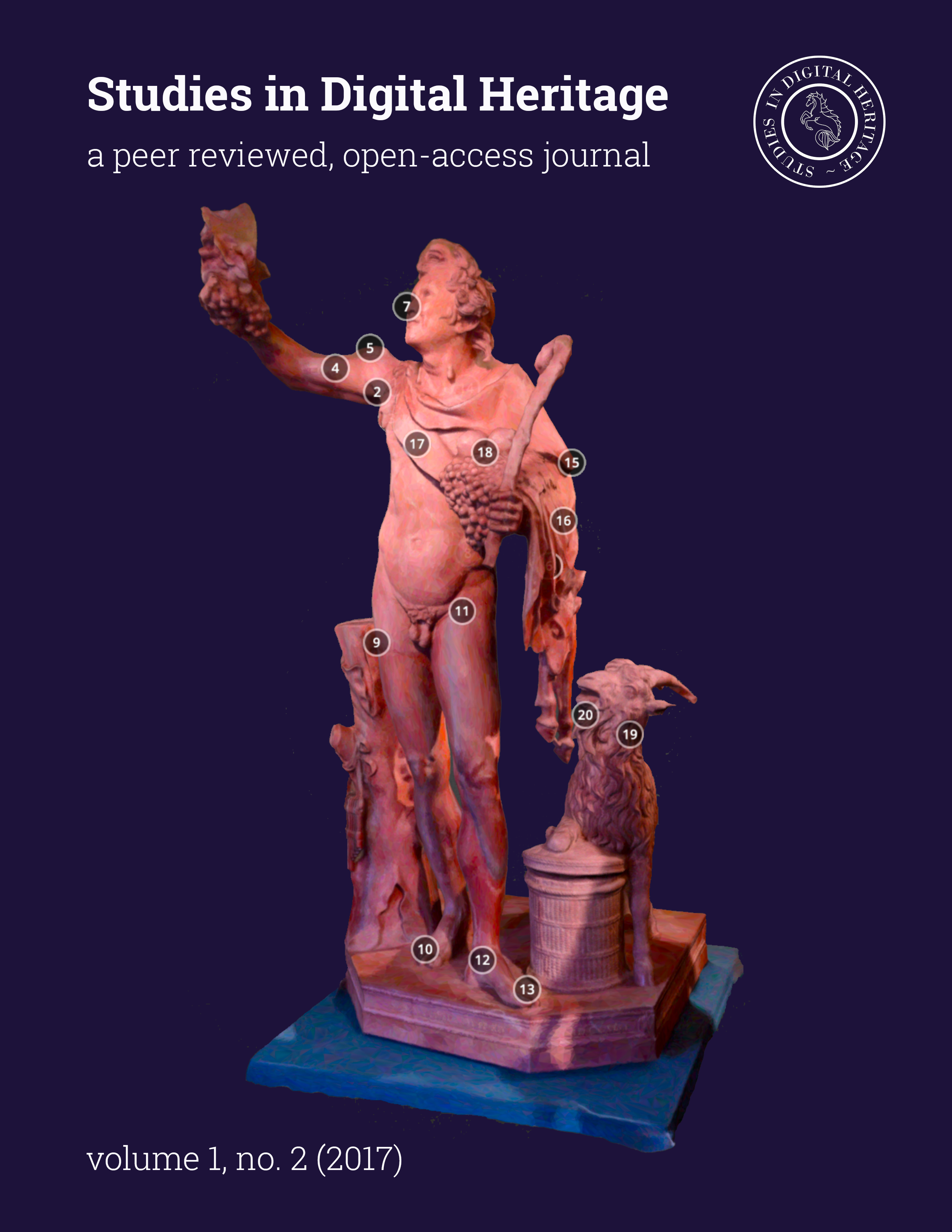A Medieval Bishop's Palace in Milicz: 3D Reconstruction as a Method of a Research Hypotheses Presentation
Main Article Content
Abstract
Downloads
Article Details
From 18 May 2018, the contents of Studies in Digital Heritage are licensed under a Creative Commons Attribution-NonCommercial 4.0 International License (CC BY-NC 4.0). Our submitting authors pay no fee and retain the copyright to their own work.
How this works: to submit their work to the journal, authors grant Studies in Digital Heritage a nonexclusive license to distribute the work according to a CC BY-NC 4.0 license. Once an article is published, anyone is free to share and adapt its contents—provided only that they do so for noncommercial purposes and properly attribute the shared or adapted information. Details of these terms can be found on the Creative Commons website.
Download SDH’s full author agreement here
Studies in Digital Heritage will insert the following note at the end of any work published in the journal:
© [Year] by the authors. This article is an open-access article distributed under the terms and conditions of the Creative Commons Attribution License CC BY-NC 4.0 (https://creativecommons.org/licenses/by-nc/4.0/).
References
Fabrizio I. Apollonio. 2016. Classification schemes and model validation of 3D digital reconstruction process. Proceedings of the 20th International Conference on Cultural Heritage and New Technologies 2015 (CHNT 20, 2015). Vienna http://www.chnt.at/wpcontent/uploads/eBook_CHNT20_Apollonio_2015.pdf
Juan A. Barceló. 2000. Visualizing what might be: An introduction to Virtual Reality Techniques in Archaeology. In Juan A. Barceló et al. , eds. Virtual Reality in Archaeology. Oxford: Archeopress, 9-36.
Juan A. Barceló. 2014. 3D modelling and shape analysis in archaeology. In Fabio Remondino and Stefano Campana, eds. 3D Recording and Modelling in Archaeology and Cultural Heritage Theory and best practices. BAR International Series 2598, 15-23.
Anna Bentkowska-Kafel. 2008. Historyczna wiarygodność zabytku wirtualnego. Uwagi na marginesie postulatów Karty londyńskiej. In Agnieszka Seidel-Grzesińska and Ksenia Stanicka-Brzezicka, eds. Nowoczesne metody gromadzenia i udostępniania wiedzy o zabytkach. Wrocław, 44-45.
Richard Beacham et al.. 2008. An Introduction to the London Charter. http://www.londoncharter.org/fileadmin/templates/main/docs/beacham-denardniccolucci_intro.pdf
Małgorzata Chorowska. 2008. Zamek czy pałac? Ruina zamku w Miliczu na tle średniowiecznych siedzib biskupów w Europie. In Justyna Kolenda, ed. Milicz Clavis Regni Poloniae. Gród na pograniczu. Wrocław, 129-140.
Małgorzata Chorowska and Andrzej Kudła. 2005. Architektura i historia średniowiecznego zamku w Miliczu. In Małgorzata Chorowska et al. eds. Nie tylko zamki. Szkice ofiarowane profesorowi Jerzemu Rozpędowskiemu w 75 rocznicę urodzin. Wrocław, 83-96.
Hugh Denard. 2012. A New Introduction to the London Charter. In Anna Bentkowska-Kafel et al., eds. Paradata and Transparency in Virtual Heritage Digital Research in the Arts and Humanities Series. Ashgate, 57-71.
Joseph Gottschalk. 1930. Beiträge zur Rechts-, Siedlungs-, und Wirtschaftsgeschichte des Kreises Militsch bis zum Jahre 1648. Darstellungen und Quellen zur schlesischen Geschichte, hrsg. vom Verein für Geschichte Schlesiens, Bd. 31. Breslau.
Bohdan Guerquin. 1957. Zamki śląskie. Warszawa.
Bohdan Guerquin. 1974. Zamki w Polsce. Warszawa.
Sorin Hermon and Loukas Kalisperis. 2011. Between the Real and the Virtual: 3D visualization in the archaeological research - expectations and prospects. In Virtual Archaeology Review 2(4), 59-63.
David Johnson. 2008. Architectural Drafting Standards in Archaeological Computer Modeling: Reconstructions from Drawings and Surveys of the Metropolitan Museum of Art Egyptian Expedition. In CAA 2007: 3D Modelling and Visualisation
http://proceedings.caaconference.org/paper/41_johnson_caa2007/
Andrzej Kudła. 1988. Kontynuacja badań na zamku w Miliczu. Wrocław. The typescript is in the archives of Wojewódzki Urząd Ochrony Zabytków in Wrocław.
Małgorzata Markiewicz. 2014. Archeologia wirtualna – zagrożenie czy przyszłość. Rekonstrukcja 3D w archeologii. In Agnieszka Seidel-Grzesińska and Ksenia Stanicka-Brzezińska, eds. Obraz i metoda. Wrocław, 190-197.
Józef Plich. 1978. Zabytki architektury Dolnego Śląska. Wrocław-Warszawa-Kraków-Gdańsk.
Alexandra Riedel and Thomas Bauer. 2008. Pretty and Useful? – Three-dimensional Computer Models as a Working Tool for Documentation and Investigation in Building Archaeology. In CAA 2007: 3D Modelling and Visualisation. http://proceedings.caaconference.org/paper/40_riedel_bauer_caa2007/
Jerzy Rozpędowski and Andrzej Kudła. 1987. Badania archeologiczno-architektoniczne zamku w Miliczu. Wrocław. The typescript is in the archives of Wojewódzki Urząd Ochrony Zabytków in Wrocław.
Borys Sierwczyński. 2004. Zabytki architektoniczne Ostrowa Lednickiego w rekonstrukcji komputerowej. Lednica-Poznań.
Thomas Strothotteet al. 1999. Visualizing Knowledge about Virtual Reconstructions of Ancient Architecture, Proceedings of Computer Graphics International’99, The Computer Graphics Society. IEEE Computer Society. Los Alamitos, USA 1999, 36-43. https://tobias.isenberg.cc/pe
Stella Sylaiou and Petros Patias. 2004. Virtual Reconstructions in archaeology and some issues for consideration. In The Annual Journal for Culture and Technology published by the Foundation of the Hellenic World, 4. http://www.ime.gr/publications/print/imeros/en/04/article01.html


